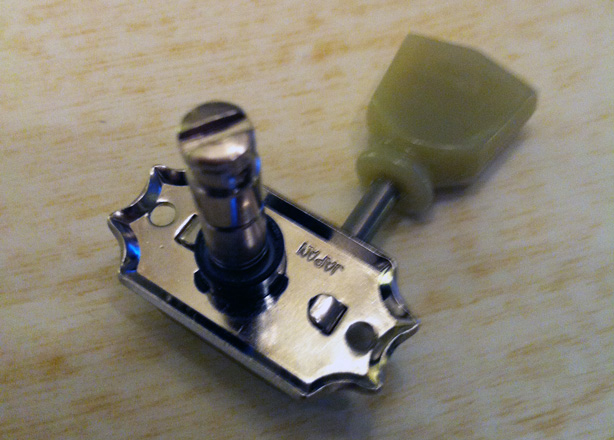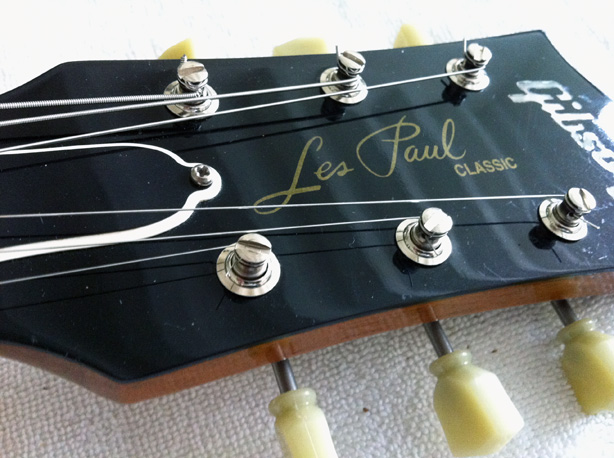Thanks to the folks at G-Jax, I now have a wonderful set of Gotoh SD510 Kluson-type replacement tuners fitted to my Gibson Les Paul Classic.

New tuners, unpacked, and ready to go!

The kit comes with push-in replacement bushes, mounting screws, a punch for driving out the old bushings, plus a tool for checking that the existing post holes are the correct size for the new tuners. As this is a drop-in replacement for the original tuners, theoretically, everything should fit without any woodworking required.

As you can see, these are identical to the original tuners, save for the Magnum Lock mechanism at the top of the tuner post.

The colour match of the tuner key is very good, and looks identical to the originals – although these iPhone photos don’t necessarily show this very clearly.

The Magnum Lock system is mechanically very simple and doesn’t require any tools, except for a plectrum in the top slot when removing strings. Perhaps a bit more fiddly to do an emergency re-string mid-gig than alternative locking systems such as Schaller and Plant Waves, but this is the only Kluson-style locking tuner on the market.

Before modification: Front of headstock with original tuners.

Before modification: Rear of headstock with original tuners.

First job is to remove the strings, of course.

Flip the guitar over, then remove the machinehead mounting screws (2 per tuner) and carefully remove the tuners from the headstock. I don’t have a fancy workbench, so I just used a thick towel to protect the guitar finish and table top.
Next job is to drive out the original tuner bushings using the punch supplied in the Gotoh kit. This needs to be done from the rear of the headstock, so flip the guitar onto its front and make sure that you have something supporting the headstock, so that you have something to work against when using the punch and to protect the face of the headstock when doing so. I used a rolled up towel to support the headstock – which worked fine. I found that a couple of quite hefty taps with the hammer were required to pop them out. Mine came out very cleanly indeed, without any damage to the headstock finish. Phew!

The next step is very important. You need to use the tool supplied with the Gotoh kit to check that the tuner post holes are the correct size. Interestingly, I found that the tuner mechanisms fitted perfectly on the rear of the headstock (a shug fit, no real force needed to push the tuner into place), but that the Gotoh tool didn’t quite fit into the holes from the front of the headstock. So, all I did was to take a medium round file and very lightly smooth out the hole working from the front of the headstock. The idea isn’t really to enlarge the hole, rather it’s to smooth and remove any excess lacquer, etc, to enable the new bushings to go in without too much effort. Remember, this is a replacement kit and no woodworking is required! All I did was very lightly run the file a few strokes up and down the hole – nothing more than that.
Next job is to fit the new Gotoh bushings. Again, make sure the headstock is adequately supported (I used a rolled up towel), and then tap each bushing into place with a hammer – taking care not to let the hammer hit the face of the headstock. I soon found that the secret to tapping these in without too much effort is to make sure that the bushing is first pushed in as much as possible by hand, making sure that it is straight and square. Three or four firm taps with the hammer soon had the bushings in place and no damage to the headstock, either.

Once the bushings are in, flip the guitar over and fit the new machineheads. Another important point to note: pay attention to the size of the string holes at the top of the tuner posts. The three tuners with the large string holes go on the “top” side of the headstock (ie for the E, A, and D strings, standard tuning), and the three tuners with the small string holes go on the “bottom” side (ie for the G, B and top E string). Incidentally, I decided to use the slightly longer screws (than the originals) supplied with the kit.

And here’s a topside view showing the lovely, shiny new Gotoh tuners ready for action. Ignore the colour reproduction in this photo – I can assure you that the colour of the pegs is almost identical to the originals (see detail close-up earlier in this article).

And here’s the guitar re-strung and good to go.

Conclusion
I’m very happy with these tuners, aesthetically and functionally. They look great, virtually identical to the originals, and work fantastically well to keep the guitar in tune. They are not cheap (approx USD 180 including delivery and Swiss import duty/VAT), but I think they’re worth it. By the way, these models are built to order, with a lead time of around three weeks. I think I received mine almost exactly three weeks after I placed the order at G-Jax.
Highly recommended!
Related articles
See more articles about this guitar:
- Les Paul Classic – Pimping my ride – Part 1
- Les Paul Classic – Pimping my ride – EMP pickup installation


Troy Manson
Thanks for your review and how to with the gotoh tuners, I am about to buy a set for my les Paul classic as well, did you get the standard height tuners or the H.A.P ones?
Ade
I bought the Magnum Lock version which, I assume, uses the Standard post height. Here’s the product code for the ones I bought: SD510-MG-N-SL-L3R3
As you can see from the photos, they are a direct replacement.
Troy Manson
Cool, thanks for the great blog!
Otto Zeides
Thank you for your detailed story. I have done it a few months ago with my Tokai ES110 (without the Locking). Works very well. Now i have a brand new Gibson R8 (2012) VOS, but think she needs this too. But i’m a little bit nervous doing it myself on this guitar.
Great blog by the way.
Ade
Thanks!
I was nervouse when working on the Les Paul, but it was fine in the end. I’ve since done the same mod to another LP without problems. I don’t care what people say, but swapping out the tuners has made the tuning stability excellent – almost as good as my ESP Eclipse.
Not sure I’d have the nerve to do it to a R8 VOS, but if you’re careful it should be fine. Good luck!